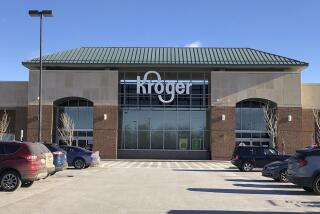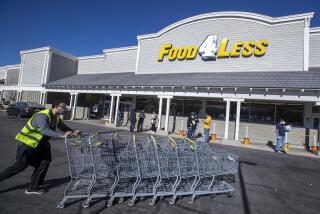Now Bouncing Back, Kellogg Is Looking Past Breakfast
- Share via
BATTLE CREEK, Mich. — Soy protein cereal and veggie burgers. New promotional characters, joining Snap, Crackle, Pop and Tony the Tiger. The closure of the company’s oldest Corn Flakes facility, and the loss of more than 500 jobs.
Kellogg Co. has had a busy 12 months--except in the breakfast cereal aisle, where tough competition continues to lure customers away from the products that made it famous. But with first-quarter earnings up nearly 12% and the company reporting its fourth consecutive quarter of growth, executives hope to convince Wall Street that Kellogg is headed in the right direction after years of disappointing results.
“I think there have been many changes for the better, even if the stock price is low,” said John McMillin, an analyst at Prudential Securities. “But it’s hard to turn around.”
“You had a company that was in the emergency ward, and sometimes it takes a while to get out of the hospital,” he said.
The ready-to-eat cereal market has shrunk in recent years as fewer Americans have the time to sit down for breakfast. And competition in the cereal aisle has become more intense, both from brand-name and private label companies.
“My husband likes Kellogg cereals. But he tends to eat granola bars and bagels on the way to work,” said Jeannie Hustosky, of Grand Rapids, who does the shopping for her family.
Although Kellogg is the unrivaled worldwide leader in cereal sales, amid the industrywide decline the company’s revenue and earnings growth has been erratic since 1995.
And the number of cereal boxes Kellogg sold in the United States continued to drop for the year ending March 6, falling more than 6%, according to Chicago-based Information Resources Inc.
Kellogg’s stock price also has suffered. It hovered around $25 per share the week of May 1, after trading as high as $40 last fall and reaching $50 in late 1997.
Chief executive and chairman Carlos Gutierrez acknowledges Kellogg’s stock price could be higher, but contends the company is getting stronger, pointing to low double-digit growth in its earnings and a stabilization of its market share.
“We want to break away from the pack of food companies. We don’t want to be stuck,” he told shareholders last week at the annual meeting.
He outlined his vision of Kellogg’s future: a company where noncereal products account for 40% of its revenues, compared to 24% today. The wider variety of products, he believes, will increase Kellogg’s competitiveness.
More money is also being spent on marketing and advertising. Last week, Kellogg unveiled its first new characters in 30 years: EET and ERN, who join Snap, Crackle, Pop and Tony the Tiger, well-known promotional characters for Kellogg. EET, a horse, and ERN, a pig, are part of a new Internet-based program that allows consumers to earn points from selected products and redeem them online at Web sites like toysmart.com and fogdog.com.
“This could be the way cereal promotions are done in the future,” said Gutierrez. “Kellogg is out front on this.”
Gutierrez’s optimism comes after a year of change. Since becoming chief executive in April 1999, he has replaced or reshuffled eight of the company’s top 10 executives.
Citing cost inefficiencies, Gutierrez closed the company’s oldest Corn Flakes plant, which dated to the 1900s, and he eliminated more than 500 jobs. The moves will give Kellogg’s estimated annual savings of $35 million to $45 million.
In addition, Gutierrez has spent the past year expanding the company’s emphasis on convenience foods, such as Rice Krispie Treats squares, Nutri-Grain Twist bars and Snack ‘Ums. He also has shifted considerable resources into developing nutritionally enhanced foods, including a new soy breakfast cereal released earlier this year.
In October, Kellogg acquired Worthington Foods, an Ohio maker of vegetarian burgers and other products for $307 million--less than a month after selling Lender’s Bagels for $275 million, 41% less than its purchase price.
“We know there’s a trend towards vegetarianism,” Gutierrez said of the acquisition. “Already, we’ve been able to improve four or five of their products.”
Future acquisitions of other companies are possible, according to Gutierrez.
But more job cuts may also be on the way, this time in Europe. According to Kellogg’s annual report, the company expects to record a $25 million restructuring charge in its overseas operations during the second quarter.
So far, the company remains confident its strategy is correct, a sentiment shared by the board members, who stand behind the more than $1 million and 80,000 new stock options, that Gutierrez earned last year.
“While the performance of the company’s stock has been disappointing, the committee believes Mr. Gutierrez has developed a promising business strategy,” members wrote in a statement mailed to investors before the annual meeting.
Ultimately, however, the future of Kellogg’s likely will turn on the decisions of consumers like Beverly Shepard, a Grand Rapids mother.
“I pulled them off the shelf because they were on sale,” she said, pointing to a box of Kellogg’s Fruit Loops in her shopping cart. “My kids hate the generic cereals, so I buy them brand names when they’re on sale. If Kellogg’s cereals aren’t on sale, I buy something else.”
More to Read
Inside the business of entertainment
The Wide Shot brings you news, analysis and insights on everything from streaming wars to production — and what it all means for the future.
You may occasionally receive promotional content from the Los Angeles Times.










